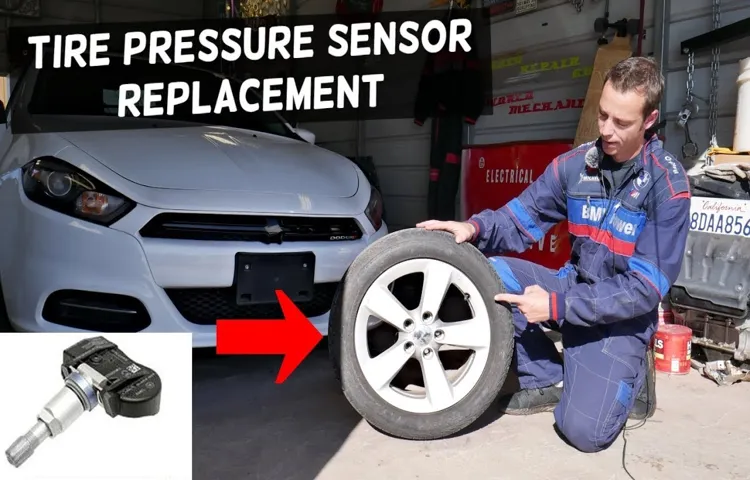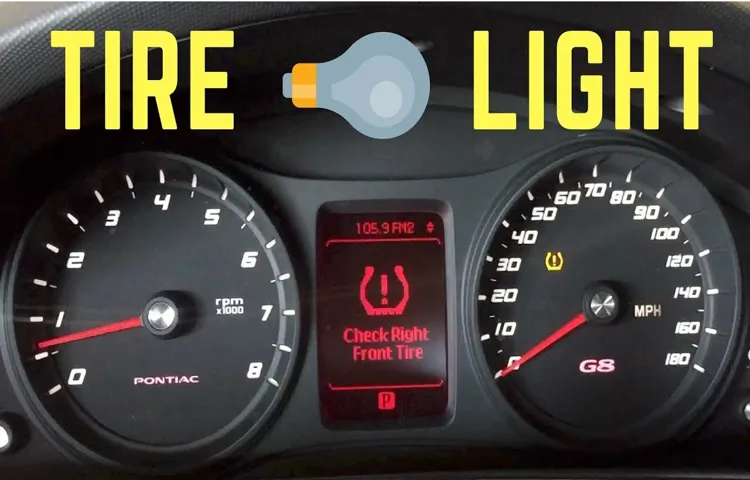Are you tired of seeing that pesky tire pressure light on your dashboard? Whether you’re a seasoned car owner or a beginner, the task of syncing tire pressure sensors can seem daunting. But fear not! With a few simple steps, you’ll be able to sync your sensors in no time. First, make sure that all of your tires are properly inflated to their recommended pressure levels.
Next, locate the TPMS reset button, which is typically located on the dashboard or under the steering wheel. Press and hold the button until you see the TPMS indicator light blink slowly. Now, it’s time to sync your sensors.
Start by placing the TPMS tool near the valve stem of the tire you want to sync. Press the tool’s button to activate it and wait for the horn to sound, indicating that the sensor has been synced. Repeat this process for all of the tires.
It’s important to note that different car models may have slightly different steps for syncing their sensors, so be sure to consult your car’s manual if you’re unsure. Incorporating regular tire pressure sensor checks into your car maintenance routine can not only save you money on tire replacements, but also improve your overall safety on the road. Don’t let a blinking dashboard light stress you out – take control and sync those sensors!
Table of Contents
Understanding Tire Pressure Sensors
If you are experiencing issues with your tire pressure sensors, the first step is understanding how to sync them. Synching your tire pressure sensors can be done easily with the right tools and knowledge. First, make sure your tire pressure is correct according to your vehicle’s owner manual.
Then, locate the sync button on your vehicle dashboard or TPMS tool, and press and hold it until the light on the tool flashes. Next, place the TPMS tool near each tire valve stem and press the tool’s button. This will sync your tire pressure sensors and reset any warning lights on your dashboard.
Remember to repeat this process whenever you rotate or replace your tires. With these simple steps, you can save time and money by maintaining proper tire pressure and avoiding unnecessary repairs or replacements.
What are Tire Pressure Sensors?
Tire pressure sensors are devices that monitor the air pressure in your tires, sending data to your vehicle’s computer system. They use either direct or indirect methods to measure the pressure and detect any significant changes. Direct sensors attach to the inside of the tire and provide real-time pressure measurements while indirect sensors gauge pressure levels through other vehicle signals, such as ABS.
The primary purpose of these sensors is to alert you when the tire pressure levels drop below a predetermined threshold, allowing you to avoid accidents, tire blowouts, and reduce fuel consumption. Without tire pressure sensors, you would have to manually check the pressure levels regularly, which can inconvenience and endanger you if neglected. Understanding the importance of these sensors is essential for safe driving, ensuring your vehicle performs at its best, and prolonging tire life.

How do They Work?
Tire pressure sensors are an essential component in modern vehicles that helps maintain optimal tire pressure for a safer and smoother ride. These sensors work by monitoring the air pressure in each tire using built-in sensors that transmit data to the vehicle’s onboard computer. The computer then analyzes the data and alerts the driver with a warning light on the dashboard if the tire pressure drops below the recommended level.
This warning allows the driver to take the necessary action, fill the tires with air, or check for any leaks. Tire pressure sensors come in two types, direct and indirect, but both function to ensure better safety and performance on the road. With the help of tire pressure sensors, drivers can avoid costly repairs and ensure their vehicle’s longevity while maintaining optimal performance.
Signs that Your Tire Pressure Sensor Needs Syncing
If you’ve ever noticed the tire pressure warning light on your dashboard but don’t remember the last time you checked your tire pressure, it might be time to sync your tire pressure sensors. Signs that your tire pressure sensor needs syncing include the warning light staying on even after adding air to your tires, the warning light not coming on at all when your tire pressure is low, or the warning light flickering on and off randomly. To sync your tire pressure sensors, consult your vehicle’s manual or take it to a mechanic who can recalibrate the sensors.
Regular syncing of your tire pressure sensors can ensure that you maintain optimal tire pressure, which can increase your vehicle’s fuel efficiency and overall safety on the road.
Dashboard Warning Lights
Dashboard warning lights can be a real headache to deal with, especially when you’re not exactly sure what they’re trying to tell you. One common warning light that you shouldn’t ignore is the tire pressure sensor light. This light often looks like an exclamation point inside of a horseshoe and typically means that one or more of your tires has low pressure.
However, if you’ve recently filled your tires and the light is still illuminated, it could mean that your tire pressure sensor needs syncing. This is a simple process that can often be done manually by following the instructions in your car’s owner manual. However, if you’re not comfortable doing this yourself, it’s always a good idea to take your car to a licensed mechanic who can help you reset the tire pressure sensor and ensure that your tires are safe and properly inflated.
So, if you see that pesky tire pressure sensor light illuminated on your dashboard, don’t ignore it. Instead, take action as soon as possible to keep your car, and yourself, safe on the road.
Reduced Fuel Efficiency
If you’ve noticed that your car’s fuel efficiency has reduced, it could be due to tire pressure issues. One of the signs that your tire pressure sensor needs syncing is when your tire pressure warning light illuminates on your dashboard. This means that the sensor is picking up on an issue with your tire pressure, and it’s a sign that you need to take action.
In addition to the illuminated warning light, you may also notice that your car feels less stable on the road or that the ride feels rougher than usual. These symptoms can be the result of a tire that is either overinflated or underinflated. The good news is that syncing your tire pressure sensor is a simple process that can be carried out by most mechanics or even done at home with the right tools.
By taking care of your tire pressure, you can improve your fuel efficiency and enjoy a smoother ride on the road.
Handling and Control Issues
As a driver, it’s crucial to keep an eye on your tire pressure and ensure that it’s at the optimal level. One way to do this is by relying on tire pressure sensors. However, there may come a time when these sensors need syncing to function properly.
Signs that your tire pressure sensor needs syncing include incorrect pressure readings, low battery warnings, or the sensor failing to activate. If you notice any of these signs, it’s best to address the issue promptly to avoid tire handling and control issues. By syncing your sensors, you can ensure that your vehicle is performing optimally, keeping you and other drivers safe on the road.
Remember, your tire pressure sensors are a crucial part of your vehicle’s safety system, and keeping them in proper working order can help you avoid potentially dangerous situations.
Step-by-Step Guide to Syncing Tire Pressure Sensors
Are you wondering how to sync tire pressure sensors? It’s an important task to ensure your safety on the road and to maintain optimal tire performance. Here’s a step-by-step guide to help you through the process. First, make sure your vehicle is in “park” and the ignition is turned on.
Next, locate the sensor reset button (usually found in the glove compartment or under the driver’s side dashboard). Press and hold the button until the tire pressure monitor light blinks two or three times. Now, starting with the driver’s side front tire, use a tire pressure gauge to check the pressure and adjust if necessary.
Then, move on to the passenger side front tire, followed by the passenger side rear tire, and finally the driver’s side rear tire. After each tire is checked and adjusted, go back to the sensor reset button and press it again to confirm the changes. That’s it – your tire pressure sensors are now synced and ready to go!
Step 1: Park and Turn Off Vehicle
If you’re having trouble syncing your tire pressure sensors, don’t worry – it’s actually a very simple process. The first step is to park your vehicle and turn it off. This will ensure your tires are stationary and the sensors have a chance to reset themselves.
Next, locate the device used to sync the sensors. Depending on your vehicle, this could be a simple button on the dashboard or an electronic device that plugs into the car’s diagnostic port. Follow the instructions provided by the manufacturer to sync the sensors with your vehicle.
This may involve properly inflating your tires, pressing the sync button, and waiting for the sensors to register the new pressure levels. Once the syncing is complete, you should be all set to drive with properly calibrated tire pressure sensors.
Step 2: Locate Tire Pressure Sensor Reset Button
When it comes to syncing tire pressure sensors, step 2 is crucial: locating the reset button. While different vehicles may have different locations for this button, it is typically found either under the steering wheel or in the glove box. Once you find the button, press and hold it until the sensor light blinks, indicating that it has been reset.
It’s important to note that syncing your tire pressure sensors is important for both your safety and the longevity of your tires. Keeping your tires at the proper pressure can improve gas mileage, prevent tire blowouts, and increase overall vehicle performance. Don’t hesitate to check and reset your tire pressure sensors regularly, as it can save you time, money, and ultimately keep you safe on the road.
Step 3: Inflate Tires to Recommended Pressure
When it comes to maintaining your vehicle’s tire pressure, syncing tire pressure sensors is a crucial step. The third step involves inflating your tires to the recommended pressure. Refer to your vehicle’s manual or the sticker on the inside of the driver’s door to ensure you’re filling your tires to the proper pressure.
Overinflating or underinflating can lead to tire damage, poor handling, and even accidents. It’s important to note that tire pressure should be checked regularly, especially before long trips or changes in weather. With synced tire pressure sensors, you’ll be alerted to any changes in tire pressure, helping you keep your vehicle safe on the road.
Step 4: Press and Hold Reset Button
Syncing tire pressure sensors can be a bit of a challenge, but with the right steps, it’s a breeze. Step 4 is crucial and involves pressing and holding the reset button. This button is usually located under the steering wheel, and you’ll need to use a pointed object like a pen or paperclip to press it.
Once you’ve found and pressed the reset button, hold it down until you see the TPMS light on your dashboard blink quickly. This indicates that the process has started. Keep holding the button until the light blinks slowly, indicating that the process is complete.
You can then release the reset button and start checking your tire pressure sensors. Remember to repeat this process for each tire pressure sensor if you have multiple ones. By following these simple steps, you’ll be able to keep your tires properly inflated for a safer and smoother ride.
Step 5: Wait for Confirmation
After properly inflating your tires and activating the sync mode on your tire pressure sensors, the final step is to simply wait for confirmation that your sensors are synced with your vehicle. This confirmation could come in the form of a beep, a flashing light, or a simple message on your dashboard. It’s important to keep in mind that syncing your sensors may take several minutes, so don’t be alarmed if you don’t receive immediate confirmation.
Additionally, if you encounter any issues during the syncing process, consult your vehicle manual or reach out to a professional for assistance. By following these simple steps and taking the time to sync your tire pressure sensors, you can ensure a safer and more efficient driving experience.
Tips for Maintaining Proper Tire Pressure
If you’re experiencing trouble with your tire pressure sensors, there are a few tips that can help you sync them up properly. First, make sure your tires are at the correct pressure level. You can find this information in your car manual or on a sticker located inside the driver’s door or glove compartment.
Once you know the correct pressure level, use a tire gauge to ensure your tires are properly inflated. Next, check your car’s sensor system and see if there are any error codes. If you notice any issues, it’s best to take your car to a trusted mechanic for a diagnosis.
Additionally, make sure your tires are properly aligned and balanced. This can help ensure your tire pressure sensors are working optimally. By following these simple tips, you can help to prevent tire damage, save money on fuel costs, and stay safe while driving on the road.
Regular Tire Pressure Checks
Regular tire pressure checks are crucial for maintaining the longevity and safety of your vehicle’s tires. Proper tire pressure ensures better gas mileage, reduces the risk of accidents, and extends the life of your tires. To maintain the proper tire pressure, it’s important to frequently check the pressure levels and adjust them as necessary.
The ideal tire pressure can be found in the owner’s manual or on the tire sidewall. It’s important to check the tire pressure when the tires are cold, as air expands when it heats up. Additionally, investing in a good quality tire pressure gauge allows you to have accurate readings and avoid over or under-inflated tires.
A simple task like checking your tire pressure can save you money in the long run and ensure a safer driving experience.
Proper Inflation
Proper Inflation Maintaining proper tire pressure is crucial for safe and efficient driving. Low tire pressure can harm fuel efficiency and increase the chances of accidents on the road. However, overinflating your tires is just as harmful as underinflation.
The key lies in finding the perfect balance based on the manufacturer’s recommended tire pressure. Here are some tips for maintaining the right tire pressure: Check tire pressure regularly: Tires lose air pressure over time, so regular checks, at least once a month, can save you from potential accidents and costly repairs.
Know the recommended tire pressure: The ideal tire pressure varies depending on the type and size of the tire. Check the owner’s manual or the sticker on the driver’s side door jamb for the recommended pressure for your tire.
Use a reliable tire gauge: Invest in a high-quality tire pressure gauge to measure the tire pressure accurately.
Check tire pressure when the tires are cold: Measuring tire pressure when the tire is heated can lead to inaccurate readings. Always check the tire pressure when the tires are cold, preferably in the morning before driving. Remember, properly inflated tires may not only save you money in the long run but also make sure your vehicle is safe for you and your loved ones on the road.
Choosing the Right Tires
Proper tire pressure is crucial for the safety and longevity of your vehicle’s tires. It’s important to check the tire pressure regularly, ideally once a month, to ensure it’s at the manufacturer’s recommended level. Under-inflated tires can cause increased fuel consumption and wear on the tires, while over-inflated tires can decrease your vehicle’s stability and handling on the road.
It’s also important to check the pressure when the tires are cold, as driving heats up the tires and can alter the reading. Investing in a good quality tire gauge can help you accurately check the pressure on your own. Remember, maintaining proper tire pressure not only keeps you safe on the road, but it can also increase the lifespan of your tires, saving you money in the long run.
Conclusion
In the end, syncing your tire pressure sensors is pretty simple: just follow the instructions that come with your vehicle! And while you’re at it, remember that maintaining proper tire pressure not only keeps you safe on the road, but can also improve your fuel efficiency and overall driving experience. So don’t be a deflated driver – take the time to sync those sensors and keep your tires rolling smoothly!”
FAQs
What are tire pressure sensors and how do they work?
Tire pressure sensors are devices that monitor the air pressure in your car’s tires. They work by using a small electronic sensor that is mounted inside each tire to measure pressure and transmit the information wirelessly to the car’s computer.
Why is it important to sync tire pressure sensors?
It is important to sync tire pressure sensors to ensure that they are accurately measuring the pressure in each tire. Otherwise, you may receive false readings that could lead to improper tire inflation and potential safety hazards.
How often should you sync tire pressure sensors?
It is recommended to sync your tire pressure sensors each time you change or rotate your tires, or whenever you notice a significant change in tire pressure.
Can you sync tire pressure sensors yourself?
Depending on the make and model of your car, you may be able to sync your tire pressure sensors yourself using the car’s onboard computer or a specialized tool. However, it is recommended that you consult your car’s owner manual or a professional mechanic for proper instructions.
What are some symptoms of a faulty tire pressure sensor?
Symptoms of a faulty tire pressure sensor include inaccurate pressure readings, warning lights on the dashboard, and difficulty syncing the sensors. If you suspect a problem with your tire pressure sensors, it is important to have them inspected and repaired by a qualified mechanic.
Can low battery power affect tire pressure sensor readings?
Yes, low battery power can affect tire pressure sensor readings. If the battery in a tire pressure sensor begins to weaken, it may transmit inaccurate readings or fail to transmit any reading at all.
Can tire pressure sensors be damaged by changing a tire?
Tire pressure sensors can be damaged if they are not properly handled during a tire change. It is important to use caution when removing and installing the sensors, and to avoid touching or damaging the sensor valve stem.



